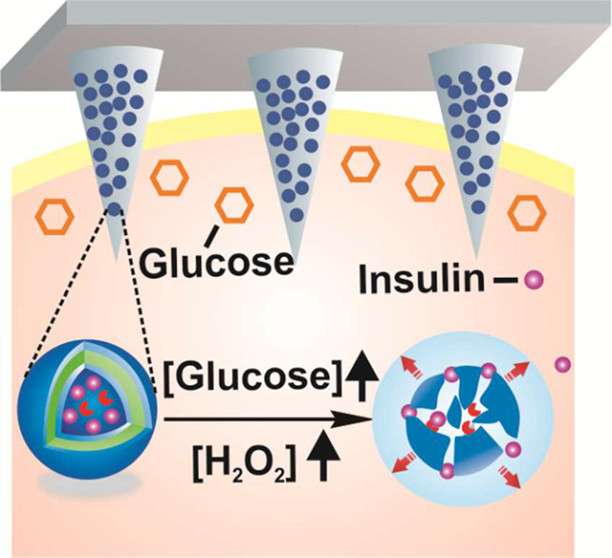Toward a 'smart' patch that automatically delivers insulin when needed

Treatment for certain diabetes cases involves constant monitoring of blood-glucose levels and daily insulin shots. But scientists are now developing a painless "smart" patch that monitors blood glucose and releases insulin when levels climb too high. The report on the device, which has been tested on mice, appears in the journal ACS Nano.
People with Type 1 diabetes don't make insulin—a hormone that regulates blood glucose, or sugar. Those with Type 2 diabetes can't use insulin effectively. Either way, glucose builds up in the blood, which can lead to a host of health problems, including heart disease, stroke, blindness and amputation of toes, feet or legs. To avoid these outcomes, people with Type 1 or advanced Type 2 diabetes regularly prick their fingers to measure blood-sugar levels, and some patients must inject themselves with insulin when needed. But sometimes, despite a person's vigilance, glucose levels can still get out of whack. Zhen Gu and colleagues wanted to come up with a simpler, more effective, shot-free way to manage diabetes.
The researchers developed a skin patch covered in painless microneedles that are loaded with tiny insulin-carrying pouches. The pouches are engineered to break apart rapidly and release the insulin in response to rising glucose levels. Diabetic mice wearing the patch maintained consistent concentrations of insulin in their blood. When these mice received a shot of glucose, their blood sugar levels spiked initially, but then fell to normal levels within two hours.
More information: Xiuli Hu et al. HO-Responsive Vesicles Integrated with Transcutaneous Patches for Glucose-Mediated Insulin Delivery, ACS Nano (2017). DOI: 10.1021/acsnano.6b06892
Abstract
A self-regulated "smart" insulin administration system would be highly desirable for diabetes management. Here, a glucose-responsive insulin delivery device, which integrates H2O2-responsive polymeric vesicles (PVs) with a transcutaneous microneedle-array patch was prepared to achieve a fast response, excellent biocompatibility, and painless administration. The PVs are self-assembled from block copolymer incorporated with polyethylene glycol (PEG) and phenylboronic ester (PBE)-conjugated polyserine (designated mPEG-b-P(Ser-PBE)) and loaded with glucose oxidase (GOx) and insulin. The polymeric vesicles function as both moieties of the glucose sensing element (GOx) and the insulin release actuator to provide basal insulin release as well as promote insulin release in response to hyperglycemic states. In the current study, insulin release responds quickly to elevated glucose and its kinetics can be modulated by adjusting the concentration of GOx loaded into the microneedles. In vivo testing indicates that a single patch can regulate glucose levels effectively with reduced risk of hypoglycemia.
Journal information: ACS Nano
Provided by American Chemical Society


















